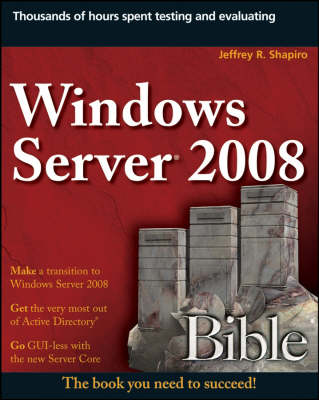Bible
2 primary works
Book 300
If Windows Server 2003 can do it, you can do it, too...This comprehensive reference provides what you need to plan, install, configure, and maintain a Windows Server 2003 R2, SP1, operating system. Covering critical new SP1 security features, the new Windows Update service, and expanded Active Directory management tools, the latest edition of this guide is packed with information, including key changes that alter the way the powerful Windows Server 2003 operating system is installed, configured, and maintained. Improve security, extend your corporate network, optimize e-mail, chat, and other communications, and more - this book will show you how.
Inside, you'll find complete coverage of Windows Server 2003* Plan your Windows Server 2003 R2, SP1, single-system or enterprise deployment* Find out the best ways to secure the network, including encryption, secure sockets, Kerberos, and other certificates* Protect your corporate network automatically with new Windows Update Service* Extend the enterprise network to branch offices with enhanced Active Directory management tools* Facilitate change control over users, computers, security, and the workspace, using Group Policy technology* Develop an effective storage, backup, and disaster recovery strategy* Implement scalable solutions that stay up and online day after day, and still handle disasters* Explore thin-client deployment, set up Terminal Services, and configure application servers* Stay on top of printer management, Internet printing, and troubleshooting Note: CD-ROM/DVD and other supplementary materials are not included as part of eBook file.
Inside, you'll find complete coverage of Windows Server 2003* Plan your Windows Server 2003 R2, SP1, single-system or enterprise deployment* Find out the best ways to secure the network, including encryption, secure sockets, Kerberos, and other certificates* Protect your corporate network automatically with new Windows Update Service* Extend the enterprise network to branch offices with enhanced Active Directory management tools* Facilitate change control over users, computers, security, and the workspace, using Group Policy technology* Develop an effective storage, backup, and disaster recovery strategy* Implement scalable solutions that stay up and online day after day, and still handle disasters* Explore thin-client deployment, set up Terminal Services, and configure application servers* Stay on top of printer management, Internet printing, and troubleshooting Note: CD-ROM/DVD and other supplementary materials are not included as part of eBook file.
Book 457
This version of the Server Bible will be the largest yet, catering to what is certainly the most advanced operating system introduced by Microsoft. The book will cater to the needs of the server administration community and will be designed to be a critical reference. The book will extensively cover the most notable new feature of Windows Server known as the "Server Core." Server Core is a significantly scaled-back installation where no graphical shell (explorer.exe) is installed, and all configuration and maintenance is done entirely through the command-line windows, or by connecting to the machine remotely using Microsoft Management Console. Server Core will also not include the .NET Framework, Internet Explorer or many other features not related to core server features. A Server Core machine can be configured for four basic roles: Domain controller, DNS Server, DHCP Server, and file server. Chapters on setup and installation will also cover the new componentized operating system Image-based setup and deployment tools, using WIM.
In addition to the already extensive Active Directory support this book will now fully cover the "Read-Only Domain Controller" operation mode in Active Directory, intended for use in branch office scenarios where a domain controller may reside in a low physical security environment, was introduced in Windows Server 2003 R2 and will be extended in the 2008 version. Chapters covering policy-based networking, branch management and enhanced end user collaboration will be extended. Windows Server 2008 will also ship Internet Information Services 7 and the current chapters on IIS will thus be extended. Coverage of Windows SharePoint Services 3.0 will also be introduced into this part of the book. We will also include coverage of the improved hot patching technology, which is a feature that allows non-kernel patches to occur without the need for a reboot. A significantly upgraded Terminal Services component, supporting RDP 6.0. will be covered in the chapter on terminal services. The most notable improvement is the ability to share a single application over a Remote Desktop connection, instead of the entire desktop.
This will be added to an already extended chapter on this remote access technology. In addition to these new features the book will also carry over existing features brought over from (SP1/R2) of Server 2003. These include covering of new security features of the operating system, Group Policy management, change control and service level, and administration practices.
In addition to the already extensive Active Directory support this book will now fully cover the "Read-Only Domain Controller" operation mode in Active Directory, intended for use in branch office scenarios where a domain controller may reside in a low physical security environment, was introduced in Windows Server 2003 R2 and will be extended in the 2008 version. Chapters covering policy-based networking, branch management and enhanced end user collaboration will be extended. Windows Server 2008 will also ship Internet Information Services 7 and the current chapters on IIS will thus be extended. Coverage of Windows SharePoint Services 3.0 will also be introduced into this part of the book. We will also include coverage of the improved hot patching technology, which is a feature that allows non-kernel patches to occur without the need for a reboot. A significantly upgraded Terminal Services component, supporting RDP 6.0. will be covered in the chapter on terminal services. The most notable improvement is the ability to share a single application over a Remote Desktop connection, instead of the entire desktop.
This will be added to an already extended chapter on this remote access technology. In addition to these new features the book will also carry over existing features brought over from (SP1/R2) of Server 2003. These include covering of new security features of the operating system, Group Policy management, change control and service level, and administration practices.

